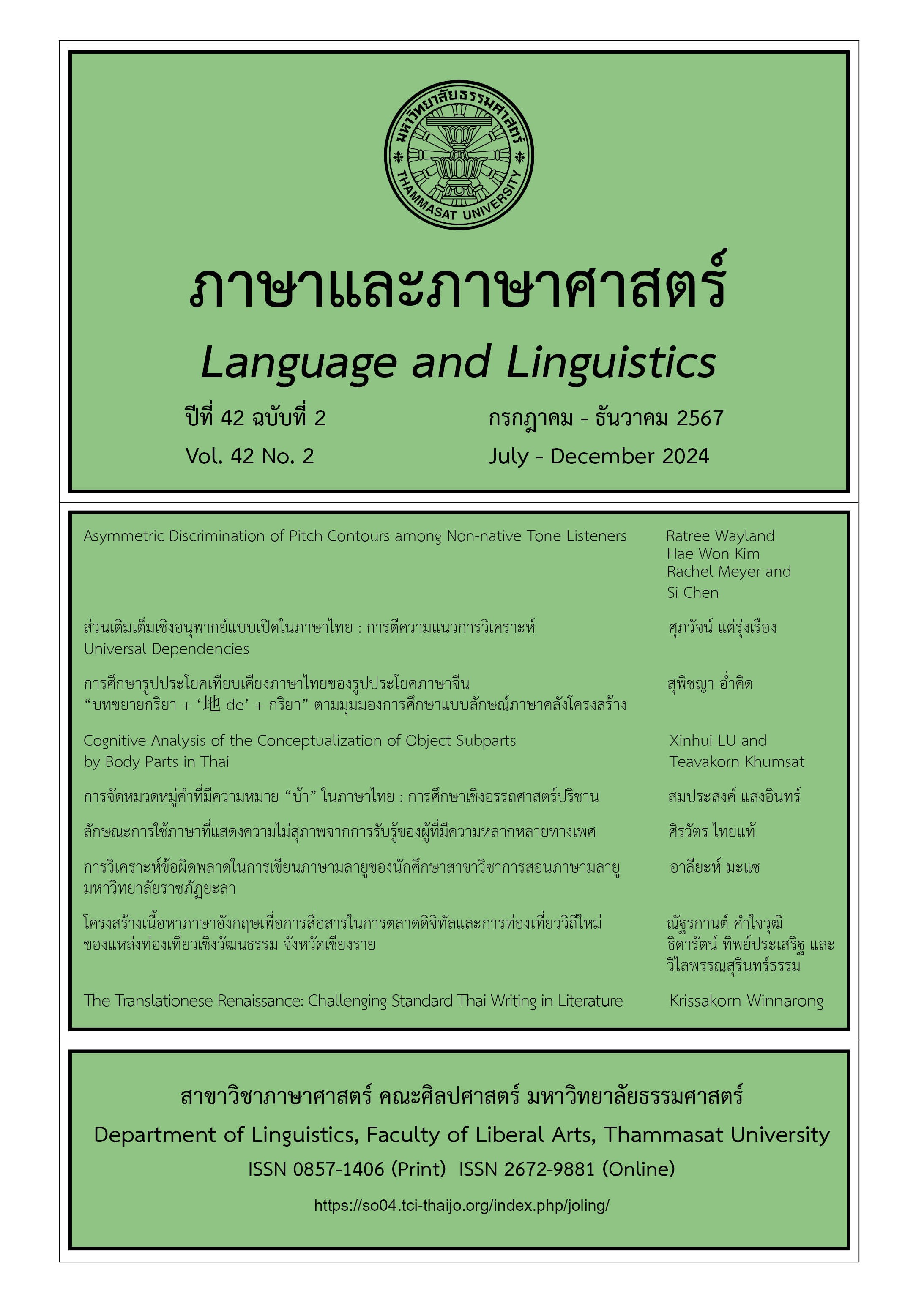A Study of Thai Sentences Compared to the Chinese “Adverbial Modifier + 地de + Verb” Construction Using Inventory Typology
Main Article Content
Abstract
This study investigates the use of Thai sentences in parallel with the Chinese “adverbial modifier + ‘地’ + verb” construction using inventory typology. The research involved gathering sentences from 21 contemporary Chinese novels and their corresponding Thai translations. The results revealed that the parallel sentences could be categorized into two types: general and special parallel sentences. General parallel sentences could be further divided into (1) verb + adverbial modifier and (2) verb + “jàːŋ” + adverbial modifier. Special parallel sentences could be categorized into six types: (1) adverbial modifier followed by the marker “地,” parallel to the first predicate, (2) adverbial modifier followed by the marker “地,” parallel to adverbs preceding the verb, and (3) verb construction with an adverbial modifier equivalent to a verb.
From a typological perspective, it can be concluded that the scope of meaning for the adverbial modifier followed by the marker “地” extends beyond merely depicting how the action is performed; it also expresses other meanings, such as the beginning of a place or the cause of an action. Thus, the construction of the adverbial modifier followed by the marker “地” should be considered a distinctive feature of the Chinese language. Additionally, the construction of the adverbial modifier followed by the marker “地” in parallel with the first predicate, especially the first verb in serial verb constructions, reflects a wide range of meanings conveyed by Thai serial verb constructions. Therefore, serial verb constructions should also be recognized as a distinctive feature of the Thai language.
Article Details

This work is licensed under a Creative Commons Attribution-NonCommercial-NoDerivatives 4.0 International License.
บทความทุกบทความเป็นลิขสิทธิ์ของภาษาและภาษาศาสตร์
References
กนกพร นุ่มทอง. (2563). การศึกษาปัญหาการแปลบทขยายและส่วนเสริมจากภาษาจีนเป็นภาษาไทย. ภาษาและภาษาศาสตร์, 38(2), 89-105.
เกรียงไกร วัฒนาสวัสดิ์. (2544). หน่วยสร้างกริยาเรียง : ลักษณะร่วมจำเพาะบริเวณภาษาเอเชียตะวันออกเฉียงใต้. วารสารมนุษยศาสตร์, 9(1), 94-109.
ณัฐนันท์ ติยานนท์. (2557). การศึกษาเปรียบเทียบนวนิยายจีน เจีย กับฉบับแปลภาษาไทย บ้าน. วารสารบัณฑิตศึกษา มนุษยศาสตร์และสังคมศาสตร์มหาวิทยาลัยขอนแก่น, 3(1), 1-26.
ปาจิณ 巴金. (2523). ตะวันดับ (เจตน์ ธรรมรังสรรค์ และ ว. วีรชัย, ผู้แปล). นพรัตน์. (ต้นฉบับพิมพ์ปี 1987).
ปาจิณ 巴金. (2524). ความพินาศ (วิวัฒน์ รุ่งวรรธนะวงศ์ และ เจตน์ ธรรมรังสรรค์, ผู้แปล). จตุจักร. (ต้นฉบับพิมพ์ปี 2008).
ปาจิณ巴金. (2525). ฤดูใบไม้ผลิ (นารียา, ผู้แปล). (ต้นฉบับพิมพ์ปี 2015).
ปาจิณ巴金. (2537). บ้าน (อนิวรรตน์, ผู้แปล). ยุคใหม่. (ต้นฉบับพิมพ์ปี 2013).
ปาจิณ巴金. (2562). หมา. ใน ปกรณ์ ลิมปนุสรณ์ (บรรณาธิการ), เกิดใหม่ในกองเพลิง (อรณิศา อุรพีพัฒนพงศ์, ผู้แปล, หน้า 165-178). มติชน. (ต้นฉบับพิมพ์ปี 2001).
สำนักงานราชบัณฑิตยสภา. (2544). พจนานุกรม ฉบับราชบัณฑิตยสถาน พ.ศ.๒๕๔๔. สืบค้นเมื่อวันที่ 22 ธันวาคม พ.ศ. 2566, จาก https://dictionary.orst.go.th/
สุพิชญา อ่ำคิด. (2567). การวิเคราะห์คำเทียบเคียงภาษาไทยของคำชี้ส่วนขยายกริยาภาษาจีน “地”จากสามมุมมอง กรณีศึกษา นิยายจีนสมัยใหม่และร่วมสมัยพร้อมกับฉบับแปลไทยจำนวน 21 เรื่อง. ใน ณัฐวุฒิ มีชัยโย (บรรณาธิการ), หนังสือรวมบทความจีนศึกษาเนื่องในโอกาสครบรอบ 25 ปีแห่งการสถาปนามหาวิทยาลัยแม่ฟ้าหลวง (พิมพ์ครั้งที่ 1, น. 1-22). https://issuu.com/imu-mfu/docs/bc2_2023?fr=xKAE9_zU1NQ
เหมาตุ้น 茅盾. (2562). ความวิปโยคของร้านค้าตระกูลหลิน. ใน ปกรณ์ ลิมปนุสรณ์ (บรรณาธิการ), เกิดใหม่ในกองเพลิง (ชาดา บุนนาค, ผู้แปล, หน้า 181-253).มติชน. (ต้นฉบับพิมพ์ปี 2017).
เหลาเส่อ 老舍. (2533). คนลากรถ (เนียน, ผู้แปล). รวมทรรศน์. (ต้นฉบับพิมพ์ปี 2022).
หวังเหมิง 王蒙. (2546). ผีเสื้อ (สมเด็จพระกนิษฐาธิราชเจ้า กรมสมเด็จพระเทพ, ผู้แปล). นานมีบุ๊คส์. (ต้นฉบับพิมพ์ปี 2006).
หลูหมิ่น鲁敏et al. (2558). รอยยิ้มและน้ำตาของหัวใจ (สมเด็จพระกนิษฐาธิราชเจ้า กรมสมเด็จพระเทพ, ผู้แปล). นานมีบุ๊คส์.
อมรา ประสิทธิรัฐสินธุ์. (บรรณาธิการ), (2549). หน่วยสร้างที่มีข้อขัดแย้งในไวยากรณ์ไทย. โรงพิมพ์แห่งจุฬาลงกรณ์มหาวิทยาลัย.
อู๋จู่เซียง 吴组缃. (2562). ของบำรุงของกวนกวน. ใน ปกรณ์ ลิมปนุสรณ์ (บรรณาธิการ), เกิดใหม่ในกองเพลิง (สุพัตรา ห. เพียรเจริญ, ผู้แปล, หน้า 255-283). มติชน. (ต้นฉบับพิมพ์ปี 2009).
Aikhenvald, A. Y., & Dixon, R. M. W. (Eds.). (2006). Serial verb constructions: A cross-linguistic typology. Oxford University Press.
Bajin 巴金. (1987). 巴金全集 (第四卷). 人民文学出版社.
Bajin 巴金. (2008). 灭亡. 上海人民出版社.
Bajin 巴金. (2013). 家. 人民文学出版社.
Bajin 巴金. (2015). 巴金选集. 第2卷, 春. 四川文艺出版社.
Dai Haoyi戴浩一. (1988). 时间顺序和汉语的语序. 国外语言学, (1), 10-20.
Laoshe 老舍. (2022). 骆驼祥子. 人民文学出版社.
Li Tianxin李田心. (2014). 翻译与语法和翻译与逻辑——兼论汉英翻译中交替运用作状语的-ed结构和with结构. 商丘师范学院学报, 30(11), 129-133.
Liu Danqing 刘丹青. (2012). 汉语的若干显赫范畴: 语言库藏类型学视角. 世界汉语教学, 26(3), 291-305.
Liu Danqing 刘丹青. (2014). 论语言库藏的物尽其用原则. 中国语文, (3), 387-401.
Liu Danqing刘丹青. (2017). 语言类型学. 中西书局.
Liu Danqing刘丹青. (2019). 语法调查研究手册 (第二版). 上海教育出版社.
Liu Danqing 刘丹青. (2022). 导语: 语言库藏类型学的理念和方法及新描写主义. 当代语言学, 24(5), 633-638.
Liu Songhan 刘松汉. (1990). 形容词作状语、补语情况再考察. 南京师大学报, (1), 66-72.
Liu Yuehua 刘月华. (1983). 状语的分类和多项状语的顺序. 语法研究和探索, (1), 32-56.
Lumin 鲁敏et al. (2019). 潮166:食色. 人民文学出版社.
Maodun 茅盾. (2017). 林家铺子: 茅盾小经典. 人民文学出版社.
National Museum of Modern Chinese Literature中国现代文学馆. (2009). 吴组缃代表作: 一千八百担.华夏出版社.
Qingye Yingmei 青野英美. (2006). 现代汉语描写性状语的类型. 中文自学指导, (4), 39-42.
Qiu Shude 邱述德. (1989). 英汉词语意义的非完全对应关系. 外语教学与研究, (1), 40-47.
Shu Huanhuan 舒欢欢. (2010). 汉泰语修饰语对比及教学对策研究, 暨南大学硕士学位论文.
Tongqingbing, Liuxiqing, Wangfuren童庆炳, 刘锡庆, 王富仁. (2001). 中学生课外阅读与欣赏中国当代小说卷. 四川人民出版社.
Wangmeng王蒙. (2006). 王蒙精选集. 北京燕山出版社.
Wang Suhua 王素华. (2008). 汉语与泰语定语、状语语序的比较研究, 厦门大学硕士学位论文.
Xiong Wenhua 熊文华. (1996). 汉英定语、状语、宾语的位置, 世界汉语教学, (4), 69-73.
Xu Yulong 许余龙. (1992). 对比语言学的定义与分类, 外国语 (上海外国语学院学报), (4), 12-17.
Yan Xueyun 颜雪云. (2009). 汉泰状语的比较, 北京语言大学硕士学位论文.
Zhang Wangxi 张旺熹. (2019). 汉语作为第二语言教学的语法与语法教学研究. 商务印书馆.
Zhao Sankun 赵三坤. (2015). 泰汉教学中的泰汉谓词修饰语问题研究, 广西大学硕士学位论文.


